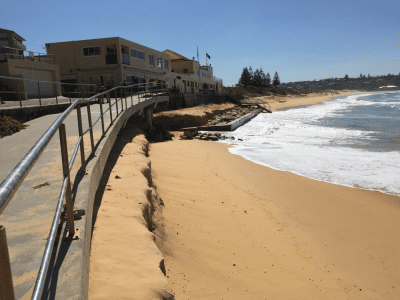NSW COASTAL CONFERENCE 2016: CELEBRATING 25 YEARS AND SURGING AHEAD

The Kurnell Dunes. (photo source: Teda Inc.)
In November we celebrated 25 years of NSW Coastal Conferences at Coffs Harbour. This is a marvellous record of commitment to coastal management in New South Wales. I have had the privilege of attending all 25 and was invited to reflect on the achievements and activities of the conferences in an opening address this year. The only interruption was in 2002 when NSW and Queensland co-hosted Coast to Coast at Tweed Heads.
Conferences started in Yamba in 1991 sponsored by the then Maclean Shire Council and the then Public Works Department. The late Joy Matthews, a councillor at the time, and Mike Geary of PWD were instrumental in establishing the conferences. They have all been based in regional coastal NSW, at very attractive coastal locations; we have never held a NSW conference in Sydney. This is a testimony to the desire and interest that local councils have in being a key partner in coastal management in this state. Thirteen councils have served as host some three times. Plans are underway for three new host councils over the period 2017 to 2019. Over the years the average attendance has been around 250 with participants from a wide range of interests, disciplines and ages including local government (staff and councillors), state agencies, academia, consultants and community groups. We have always welcomed visitors from interstate and overseas. Over this period four state Ministers have played an active role, in particular the current Minister for Planning, Rob Stokes MP, who has presented at the last 3 conferences on aspects on NSW coastal reforms. Each conference has been sponsored by one or more state agency besides the local host council. There have been many changes in the name of the key supporting agency from PWD in 1991 to OEH in 2016, but that support has been invaluable in maintaining the momentum of these conferences despite the many changes in personnel, direction and ministers. Consulting firms and exhibitors have also been highly supportive over the entire period. Each year a new organising committee is established and its role is vital to the success of each conference.
The structure of the coastal conference was set in 1991. Keynote speeches, technical papers, poster sessions, trade displays, field trips and of course receptions and dinners characterise each conference. Awards were added in 2000. There have been many memorable keynote addresses. Overseas guests offer an opportunity to meet and hear from highly experienced practitioners in coastal science, economics, engineering and management.
This year we had the pleasure of hearing from the Principal Economist of The Balmoral Group, Valerie Seidel, and the more personal stories of Dr Charlie Veron of coral reef fame. Historians, lawyers, planners, climate scientists and many others have provided stimulating addresses. I have counted 1070 technical papers between 1991 and 2016. Up to 2005 they were distributed to participants in hard copy, now they are online and only paper abstracts are made available at each conference. We are trying to get all proceedings scanned.
From 1991 to the present there have been a number of topics that recur each year. Coastal hazards is one along with discussion of potential climate change impacts. Estuarine and coastal lake health and ecosystems are also common topics together with consideration of lake entrance dynamics. The role of community groups is also frequently considered. However, over the years several matters seem have received less attention including the Commonwealth Government activities, sand mining, acid sulphate soil issues and the curse of bitou bush. Topics of interest to coastal engineers and geosciences are ever present, but it is really the cross disciplinary character of the sessions that is a feature reflecting the broad spectrum of interests of coastal managers and community groups in this state. Several places get mentioned again and again over the years as would be expected because they are locations of concern, either as so-called hotspots, or they demonstrate the need to better understand the stresses on open coast, estuary and lake environments under pressure from so many forces.
I have many memorable moments from all these conferences. I asked others to tell us the moments or events that captivated them whether they be the after-parties, the awards, the field trips, particular presentations or whatever. One I must mention is the role played by East Coast Conferences in their continued support since 2006 of the NSW Coastal Conferences. Their web site contains the records and papers since that time.
We collectively form a “coastal family” that has its annual get-together to enjoy each other’s company through exchanging ideas and concerns, in being further informed of coastal issues, and just having fun. Continuity is essential and the next few years will be most exciting as we will have the opportunity to comment on the new coastal reforms that have been rolled out this year.
I would like to thank all those participants past and present who have made all these conferences such a success.
Words by Prof Bruce Thom. Please respect Bruce Thom’s thoughts and reference where appropriately: (c) ACS, 2016, posted 5th December 2016, for correspondence about this blog post please email admin@australiancoastalsociety.org


